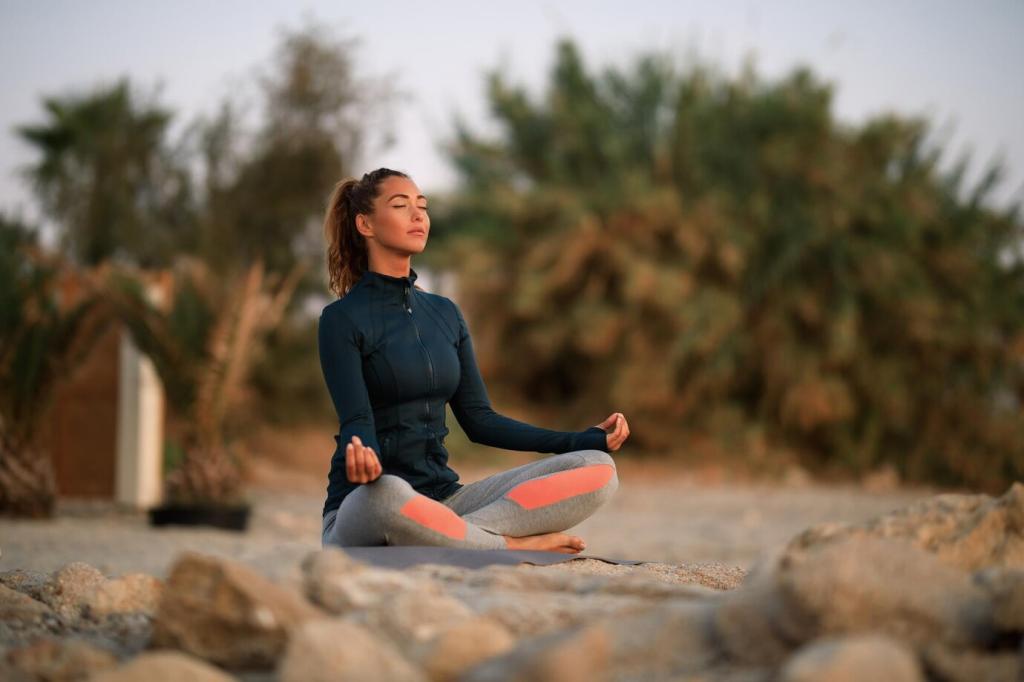Mindfulness Meditation for Reducing Anxiety

What Anxiety Is, and How Mindfulness Meets It
Anxiety often lights up the amygdala, narrowing focus and priming the body for threat. Mindfulness strengthens prefrontal regulation, helping you notice signals early, pause, and choose a kinder response rather than being swept away by racing thoughts.

Set your posture and intention
Sit upright yet relaxed, feet grounded, shoulders soft. Let your hands rest easily. Whisper an intention: “May I meet this moment with kindness.” Tell yourself you are practicing, not performing. The goal is gentleness, not perfection or total calm.
A five-breath cycle, step by step
Inhale through the nose for a steady count of four; pause softly; exhale for six, like fogging a mirror quietly. Repeat for five cycles. Notice the chest, belly, and jaw. If thoughts rush in, gently return to counting the next exhale.
Gentle fixes for common hurdles
If breath feels tight, shorten the counts and focus on the exhale. If restlessness rises, open your eyes and anchor to a familiar object. If judgment appears, note “judging,” smile inwardly, and continue. Consistency matters far more than intensity.
When you sweep attention through the body, you shift from rumination to felt experience. This grounded awareness signals safety, softens muscle guarding, and reduces cognitive load. Many find their thoughts quiet naturally as the body receives warm, steady notice.
Body Scan to Release Hidden Tension
Mindfulness Woven Into Everyday Moments
Anchor in the senses during transitions
Between tasks, pause for three breaths. Name five things you see, four you feel, three you hear, two you smell, one you taste. This sensory reset closes one chapter, opens the next, and helps your nervous system shift without carrying leftover tension.
A calmer email and phone routine
Before opening email, notice your posture and exhale slowly. Decide your single aim for the session. Set a gentle timer. When anxiety spikes, place one hand on the desk, feel its temperature, and release your jaw. Return to just the next helpful action.
Mindful commuting cues
At traffic lights or subway stops, feel where your body meets the seat. Inhale through the nose, exhale longer. Label nearby sounds neutrally—“engine,” “footsteps,” “announcement.” Let the ride be training for patience rather than a rehearsal of worry.
What the Research Suggests
Highlights from clinical studies
Meta-analyses of mindfulness-based programs report moderate reductions in anxiety symptoms across diverse populations. Participants often show improvements comparable to active controls. While not a magic bullet, consistent practice reliably nudges worry down and resilience up for many people.
Physiological shifts you may notice
Practitioners often experience lower perceived stress, improved heart rate variability, and steadier breathing patterns. Some studies note reduced cortisol reactivity. Subjectively, people describe quicker recovery after stress and a growing ability to notice triggers before they escalate.
Common myths to leave behind
You do not need an empty mind, incense, or hours of silence. Mindfulness is noticing, not erasing thoughts. Progress looks like faster returns to presence, kinder self-talk, and a nervous system that learns ease through repetition, not heroic willpower.
Build a Sustainable Mindfulness Habit
Commit to two minutes daily for ten days. Put it after something reliable like brushing your teeth. When resistance appears, say, “Only two minutes,” and begin. After ten days, add one minute. Small steps compound, especially when anchored to existing routines.
Share your intention with a friend, or join a small group. Swap brief check-ins after sessions. Celebrating tiny wins builds momentum and normalizes setbacks. If this resonates, leave a comment below or subscribe to join future community practice challenges together.
Use a simple calendar tick or a notes app. Record one sensation noticed and one thing you’re grateful for. Watch patterns emerge: easier mornings, softer jaw, steadier breath. Let tracking encourage curiosity, not judgment, and guide compassionate adjustments to practice.
